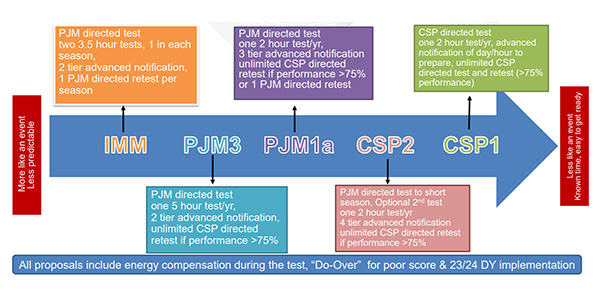By Christen Smith
VALLEY FORGE, Pa. — The Market Implementation Committee endorsed a PJM proposal on Wednesday to make demand response performance testing more realistic, resisting calls from load interests to stay close to the status quo.
Nearly 75% of stakeholders preferred PJM’s plan to replicate the “surprise element” of demand response events by revising how and when the RTO makes resources aware of upcoming tests. The current rules, developed when DR availability was limited to just six hours a day over the summer, give resources a two-day warning — down to the exact hour — and provides unlimited retesting.
Pete Langbein, PJM’s manager of demand response operations, said the RTO’s proposal — just one of five developed in the Demand Response Subcommittee and up for a vote at the MIC — would better align testing with actual event conditions and the evolution of its capacity performance construct over the last five years. Since implementing CP, DR resources must now be available 15 hours a day year-round.
“The status quo is less like an event,” Langbein said. “People schedule it far in advance and it’s only during summer. When we need these resources, they aren’t going to know a month in advance. They probably won’t even know the night before.”
In its proposal, PJM wants to perform three-hour tests in different zones once a year. The three-tiered notification system would give all zones a heads-up of who will be tested on the 21st of the month before. PJM will then give a second notification to the zone the day before the test and a third on the morning of — an attempt to balance the expensive penalties that could come from springing tests upon unprepared participants with the RTO’s desire for more realistic “surprise” conditions.
Load interests, however, believe DR is far more predictable than PJM’s proposed testing requirements suggest, noting 13 of the last 14 events since 2007 occurred during a hot weather alert.
“Test performance has always exceeded commitments and is in fact improving,” said Bruce Campbell, director of regulatory affairs for CPower. “That suggests to me a higher bar for testing isn’t going to get better event performance and there isn’t an obvious reliability issue here.”
The PJM Industrial Customer Coalition (ICC) and CPower sponsored another plan, called CSP1, that would expand testing to include winter and summer seasons but give resources notice of the test before the CP delivery year begins. They said limiting retests, as PJM suggests, skews the program’s balance and may discourage participation. In a poll distributed to the DR Subcommittee in July, 92% of participants favored this plan.
“We are supportive of CSP1 because it maintains the risk/reward profile and continues to make this a viable program for participants,” said Dave Mabry of the ICC. “If I have one bad day, I won’t lose 120% of my capacity revenue.”
Except, argues the Market Monitoring Unit (MMU), current test requirements could allow DR resources to exaggerate their capacity performance and hide reliability issues behind unlimited retests.
“If it takes you unlimited times, I don’t know if that’s a reliable resource,” said Skyler Marzewski, market analyst for the MMU. “It needs to be there when its being dispatched, otherwise it’s not reliable.”
The MMU’s proposal, which only garnered 25% of stakeholders’ votes, would have subjected resources to two tests a year and provided just two advanced warnings — the day before and the morning of — and allow just one retest. Of the five proposals, PJM’s Langbein described this plan as the closest to simulating DR conditions.
“We cannot really look at giving a resource days or weeks to prepare when an event may just give them 30 minutes,” Marzewski said.
Enel X stepped in with a fourth plan, called CSP2, as a compromise between PJM and CSP1, that would give participants one-week notice of an upcoming test. Some 53% of MIC stakeholders supported the proposal, compared to just 33% who voted for CPS1.
A second PJM plan that would have only given participants notification on the day before and the morning of earned just 15% support.
Since votes for PJM’s first plan and CSP2 exceeded the 50% threshold, both proposals will advance to the Markets and Reliability Committee later this month. In a non-binding poll conducted after the votes, 67% of stakeholders indicated they preferred PJM’s proposal over the status quo.







